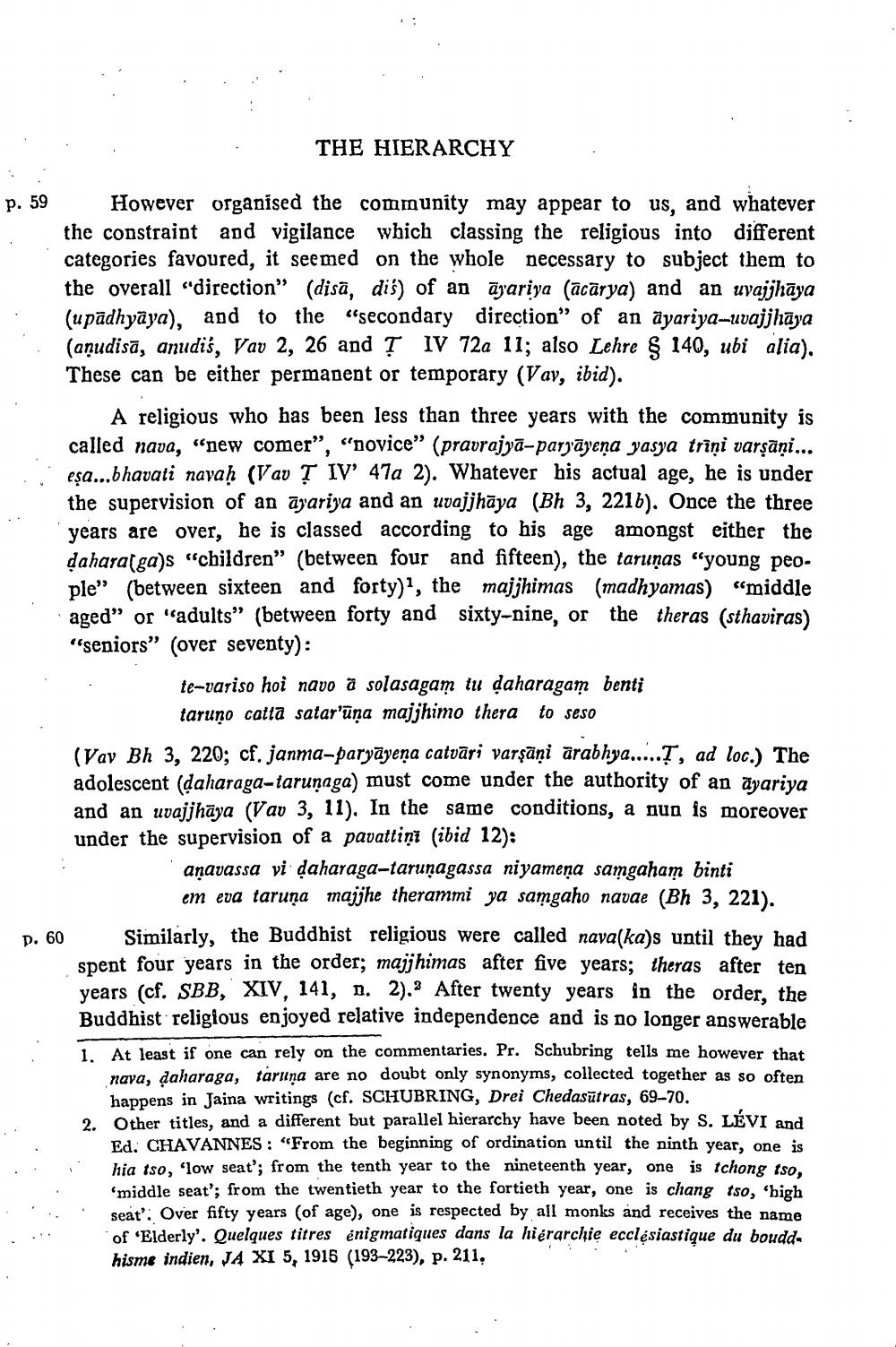________________
THE HIERARCHY
p. 59
However organised the community may appear to us, and whatever the constraint and vigilance which classing the religious into different categories favoured, it seemed on the whole necessary to subject them to the overall "direction" (disa, dis) of an āyariya (ācārya) and an uvajjhāya (upādhyāya), and to the "secondary direction" of an ayariya-uvajjhāya (anudisā, anudis, Vav 2, 26 and Ţ IV 72a 11; also Lehre § 140, ubi alia). These can be either permanent or temporary (Vav, ibid).
A religious who has been less than three years with the community is called nava, "new comer”, “novice” (pravrajyā-paryāyeņa yasya trīņi varşāņi... eşa...bhavati navaḥ (Vav Ţ IV' 47a 2). Whatever his actual age, he is under the supervision of an āyariya and an uvajjhāya (Bh 3, 2216). Once the three years are over, he is classed according to his age amongst either the dahara(ga)s "children" (between four and fifteen), the tarunas "young peo. ple" (between sixteen and forty)', the majjhimas (madhyamas) “middle aged" or "adults" (between forty and sixty-nine, or the theras (sthaviras) "seniors" (over seventy):
te-variso hoi navo o solasagam tu daharagam benti
taruno catta satar'una majjhimo thera to seso (Vav Bh 3, 220; cf. janma-paryāyeņa catvāri varşāņi ārabhya.....?, ad loc.) The adolescent (daharaga-tarunaga) must come under the authority of an āyariya and an uvajjhāya (Vav 3, 11). In the same conditions, a nun is moreover under the supervision of a pavattini (ibid 12):
anavassa vi daharaga-taruņagassa niyamena samgaham binti
em eva taruna majjhe therammi ya samgaho navae (Bh 3, 221). Similarly, the Buddhist religious were called nava(ka)s until they had spent four years in the order; majjhimas after five years; theras after ten years (cf. SBB, XIV, 141, 1. 2). After twenty years in the order, the Buddhist religious enjoyed relative independence and is no longer answerable 1. At least if one can rely on the commentaries. Pr. Schubring tells me however that
nava, daharaga, taruna are no doubt only synonyms, collected together as so often happens in Jaina writings (cf. SCHUBRING, Drei Chedasūtras, 69-70. Other titles, and a different but parallel hierarchy have been noted by S. LÉVI and Ed. CHAVANNES: "From the beginning of ordination until the ninth year, one is hia tso, 'low seat'; from the tenth year to the nineteenth year, one is tchong tso. 'middle seat'; from the twentieth year to the fortieth year, one is chang tso, 'high seat': Over fifty years of age), one is respected by all monks and receives the name of Elderly'. Quelques titres énigmatiques dans la hiérarchie ecclésiastique du boudd. hisme indien, J4 XI 5, 1915 (193-223), p. 211,
D. 60




